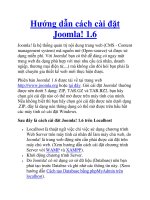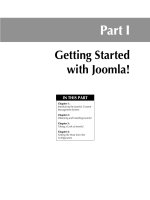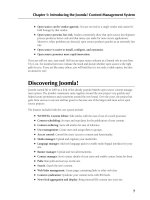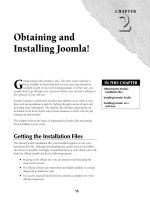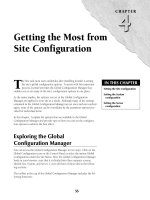joomla! 1.6 first look
Bạn đang xem bản rút gọn của tài liệu. Xem và tải ngay bản đầy đủ của tài liệu tại đây (8.88 MB, 236 trang )
Joomla! 1.6 First Look
A concise guide to everything that's new in Joomla! 1.6
Eric Tiggeler
BIRMINGHAM - MUMBAI
Joomla! 1.6 First Look
Copyright © 2011 Packt Publishing
All rights reserved. No part of this book may be reproduced, stored in a retrieval
system, or transmitted in any form or by any means, without the prior written
permission of the publisher, except in the case of brief quotations embedded in
critical articles or reviews.
Every effort has been made in the preparation of this book to ensure the accuracy
of the information presented. However, the information contained in this book is
sold without warranty, either express or implied. Neither the author, nor Packt
Publishing, and its dealers and distributors will be held liable for any damages
caused or alleged to be caused directly or indirectly by this book.
Packt Publishing has endeavored to provide trademark information about all of the
companies and products mentioned in this book by the appropriate use of capitals.
However, Packt Publishing cannot guarantee the accuracy of this information.
First published: March 2011
Production Reference: 1090311
Published by Packt Publishing Ltd.
32 Lincoln Road
Olton
Birmingham, B27 6PA, UK.
ISBN 978-1-849513-42-5
www.packtpub.com
Cover Image by Duraid ()
Credits
Author
Eric Tiggeler
Reviewers
Eric Brown
Mark Kielar
Rita Lewis
Peter Martin
Oleg Nesterov
Acquisition Editor
Dilip Venkatesh
Development Editor
Roger D'Souza
Technical Editor
Dayan Hyames
Indexers
Tejal Daruwale
Monica Ajmera Mehta
Editorial Team Leader
Aanchal Kumar
Project Team Leader
Ashwin Shetty
Project Coordinator
Michelle Quadros
Proofreader
Aaron Nash
Graphics
Nilesh R. Mohite
Production Coordinator
Melwyn D'sa
Cover Work
Melwyn D'sa
About the Author
Eric Tiggeler is the author of Joomla! 1.5 Beginner's Guide! and has written two
Dutch Joomla! guides, both of which got excellent reviews. He writes tutorials for
several computer magazines and for the Dutch Joomla! community website. Over
the last 10 years, Eric has developed numerous websites, big and small, many of
them using Joomla!.
Eric is fascinated by the Web as a powerful and creative means of communication;
and by revolutionary software such as Joomla!, enabling anybody to create beautiful
and user-friendly websites.
On a daily basis, Eric works as a consultant and copywriter at a communication
consultancy company afliated with the Free University of Amsterdam. Over the
last few years, he has written more than 10 Dutch books on writing and
communication. His passion is making complex things easy to understand.
Eric Tiggeler is married and has two daughters. He lives and works in Hilversum
(the Netherlands). On the Web, you'll nd him on
(in Dutch) and on (in English).
Any book is a team effort, so I'd like to thank everyone at Packt
Publishing for their encouragement and commitment to this project.
Thanks also to all reviewers for testing the alpha version of this book
and helping me create a thoroughly reliable nal release!
About the Reviewers
Eric Brown was born and raised in California. He joined the U.S. Navy at 17 and
became a Preventive Medicine Technician. Upon exiting military service, he left the
medical eld behind and moved to Nebraska and entered college to study art and
design, which resulted in a Bachelor's of Science in Graphic Design from Wayne State
College in Nebraska. Eric has since branched out by teaching himself (or learning
from others) various aspects of HTML, CSS, and PHP as well as a variety
of other coding languages and web marketing strategies and tools. He currently
owns his own media business located in Manhattan, KS, where he lives with his
wife and pets.
Over the years Eric has worked for a local design and development rm in Nebraska
on such projects as the Golden Spike Tower website aimed at tourist trafc centered
on the Union Pacic's Bailey Yard and with a premier pet industry design and
development rm as a project manager. He has also written for such prestigious
publications as Trafcology (a purchased print publication on web marketing read
by over 80,000 people world-wide), CMSWire.com (a leader in content management
news), ReveNews (a highly rated site on various aspects of marketing), and
Gadgetell (a well-known gadget news site).
Eric was a reviewer for Joomla! 1.5 JavaScript jQuery by Packt Publishing. He has also
been involved in other books as well providing editing, image touch-up, and custom
hand-drawn maps for Tagging Along (a Neville Family retrospective) and editing,
layout, cover art, and image touch-up on My Life and Community (Biography of Ken
Huebner).
I would like to thank all those who have helped to bring my career
to this point, but most of all I would like to thank my wife Jaime
and my two children, Ariel and Autumn, for all their patience and
understanding during the development stages of my career and
business.
Mark Kielar brings over 25 years of experience in design, photography,
commercial art, analysis, and computing to his understanding of open source content
management systems such as Joomla! 1.6. He has applied his expertise in web design
and development, writing, and editing to projects for organizations as diverse as the
Oakland California Charter Schools and Mark Brand Architecture. Mark currently
operates his own web design and content management business, Sparkling Finish, in
the San Francisco Bay Area.
I'd like to thank my good friends and Joomla! Mentor Rita Lewis at
wordstoweb.net and Mark Brand at Mark Brand Architecture for
their support in my work in website design and creation. A special
thank you goes out to a special friend, Lynne Wardell, who has
supported me for many years in all my endeavors.
Rita Lewis has been creating and managing the content of websites for small
businesses and creative organizations for the past 20 years working under the
name, Words To Web, Inc. During that time she has created and managed Joomla!
sites for independent movies for Shayanne Productions and non-prots such as
the Interfaith Community Against Domestic Violence. Rita is a regular blogger on
Freelance Switch as well as the author of 15 books on Macintosh computing and
the Internet, including titles for O'Reilly & Associates, Peachpit Press, and SAMs.
Rita has been awarded by the Computer Book Club and The Society For Technical
Communications for her efforts.
Peter Martin has a keen interest in computers, programming, sharing knowledge,
and how people (mis)use information technology. He has a Bachelor's degree in
Economics (International Marketing Management) and a Master's degree in Mass
Communication. He discovered PHP/MySQL in 2003 and Joomla!'s predecessor,
Mambo CMS, a year later. Peter has his own business (founded
in 2005) and he supports companies and organizations with Joomla! and Joomla!
extension development.
Peter is actively involved in the Joomla! community where he is a member of the
Community Leadership Team and Global Moderator at the Joomla! forum.
His other interests are open source software, Ubuntu Linux, Arduino, music
(collecting vinyl records), and art house movies. Peter lives in Nijmegen, The
Netherlands.
Oleg Nesterov is a professional web developer. He holds a Master's degree in
Mechanics and Mathematics (diploma with honors) from Sumy State University in
Ukraine. Since graduation, he has gured out the three main principles for his life:
having a mission, loving what you do, and constant self-development. He tries to
follow each of these principles in his life and job. That's why he's a web developer.
Oleg runs MindK (
), a web development company that
focuses on producing custom Joomla! extensions, templates, and websites of the
highest quality. He is an active member of the Joomla! community and speaker at
international Joomla! conferences.
He enjoys sharing his experience with others, teaching people, and creating tools
that increase developers' productivity.
You can nd more about Oleg on his personal website:
.
www.PacktPub.com
Support les, e-books, discount offers
and more
You might want to visit www.PacktPub.com for support les and downloads related
to your book.
Did you know that Packt offers e-book versions of every book published, with PDF
and e-Pub les available? You can upgrade to the e-book version at
www.PacktPub.
com
and as a print book customer, you are entitled to a discount on the e-book copy.
Get in touch with us at for more details.
At
www.PacktPub.com, you can also read a collection of free technical articles, sign
up for a range of free newsletters and receive exclusive discounts and offers on Packt
books and e-books.
Do you need instant solutions to your IT questions? PacktLib is Packt's online digital
book library. Here, you can access, read and search across Packt's entire library of books.
Why Subscribe?
• Fully searchable across every book published by Packt
• Copy and paste, print and bookmark content
• On demand and accessible via web browser
Free Access for Packt account holders
If you have an account with Packt at www.PacktPub.com, you can use this to access
PacktLib today and view nine entirely free books. Simply use your login credentials
for immediate access.
Table of Contents
Preface 1
Chapter 1: Stepping Up to Joomla! 1.6 7
Upgrading from 1.5 7
Joomla! 1.5 extension compatibility 8
Changes for templates 8
When should you move to 1.6? 9
Migrating content from Joomla! 1.5 9
What's new? A quick overview 10
1 - Usability enhancements 10
A friendlier interface 10
The great new time-saving toolbar 12
2 - Working with content 12
The endless joy of unlimited categories 12
No more ddling with menus 16
3 - New ways to manage user access 17
Do you want it simple? Keep it simple 18
4 - Working with extensions and templates 18
Updating extensions? Just lean back 18
Templating to your taste 19
SEO improvements 20
Summary 20
Chapter 2: Exploring your Enhanced Workspace 23
Before you start: choosing a safe root user's name 23
Changing the root user's name after installation 25
Logging in to the backend 26
What's changed in the backend? 27
What's gone: no more sections 28
What's been added: the Users menu 28
What's been moved: some tools and odds and ends 29
User Settings and Media Settings have been moved 30
Table of Contents
[ ii ]
Five great new time-saving features 32
Timesaver # 1: going home in one click 32
Timesaver # 2: adding new items in one click 33
Timesaver # 3: Save & New 34
Using the new Save & New button 34
Timesaver # 4: Save as Copy 36
Creating dummy content using Save as Copy 37
Timesaver # 5: tabbed screens 39
One great life-saver: two-step deletion 40
Deleting an item 40
Exploring and restoring thrashed content 41
Permanently deleting items 42
Customizing the looks of the backend 43
Selecting another backend template 44
Setting the backend template to suit your taste 45
Summary 47
Chapter 3: Organizing and Managing Content 49
Organizing content using nested categories 49
Improvement #1: categories can now be one level deep 50
Improvement #2: creating multiple category levels 51
Creating a set of 'nested' categories 52
Using nested categories in the sample data 54
Exploring the sample data 54
New category settings: notes and metadata 56
Adding category metadata 57
Fresh ways to display category contents on the frontend 58
New category view # 1: List All Categories 59
Creating a link to a site map 59
Tweaking the site map display 61
New Category View # 2: Articles Categories Module 63
New Category View # 3: Articles (in) Category Module 66
Working with the updated article editor 70
Creating a link to an article 71
Inserting an article title as a hyperlink 72
Using the updated Media Manager 73
Enabling the Flash image uploader 73
Archiving articles 75
Summary 77
Chapter 4: Managing Menus and Menu Modules 79
Goodbye to a spartan Menu Manager 80
The all-new tabbed Menu Manager screen 81
Exploring the new Menu Manager 81
Table of Contents
[ iii ]
New ways to manage and edit menus 83
A new shortcut to jump straight to selected menu items 83
A new shortcut to jump to menu module settings 83
New ways to manage and edit menu items 86
Filtering the list of menu items 86
Changes in the way you assign a menu item to the homepage 88
New buttons to copy and move menu items 88
Trashing menu items 89
Creating or editing individual Menu Items 90
Choosing from new Menu Item Types 91
New Menu Link Item type # 1: List All Categories 92
New Menu Link Item type # 2: List All Contact Categories 92
Setting the template for an individual menu item 100
An overview of Menu Item Options 100
Layout Options 100
Article Options 101
Integration Options 102
Page Display Options 103
Metadata Options 104
Module Assignment for this Menu Item 104
Summary 108
Chapter 5: Managing Site Users with Access Control 111
What's new about the Access Control Levels system? 111
What are the default user groups and permissions? 112
The default site-wide settings 112
Default user groups 114
Public – the guest group 114
Registered – the user group that can log in 114
Author, Editor, Publisher – the frontend content team 114
Manager, Administrator, Super User – the backend administrators 114
Shop Suppliers and Customers – two sample user groups 115
Are there also sample users available? 115
Action Permissions: what users can do 116
Permissions are inherited 117
What do the available action permissions mean? 118
Level 1 – site-wide permissions in Global Conguration 118
Level 2 – permissions for components 120
Level 3 – permissions for categories 121
Level 4 – permissions for articles 122
Viewing Access Levels: what users can see 123
Wrapping up: the ingredients of ACL 124
ACL at work: how to control user permissions 125
ACL example 1: allow specic users to manage contacts 125
Step 1: create a user group 125
Table of Contents
[ iv ]
Step 2: tell Joomla! what the group can see and do 126
Step 3: add users to the group 129
Check if it works 130
ACL example 2: allow users to edit one specic article 131
Step 1: create a user group 131
Step 2: tell Joomla! what the group can see and do 132
Step 3: add users to the group 134
Check if it works 136
More on Access Control 137
Summary 138
Chapter 6: New Flexibility in Using Templates 139
What's new? Finally, table-less templates 139
What does that clean output look like? 140
Why clean code is good for everybody 141
Introducing the tabbed Template Manager 142
The Styles tab: selecting templates and settings 142
Selecting a template 143
Template Styles 143
The Templates tab: exploring templates and editing code 144
Customizing templates using Template Styles 144
Changing the site color and layout options 145
Customizing the site logo 147
Using a text logo 148
Changing the header image le 149
Creating Template Styles to style individual pages 149
Creating and using a Template Style 150
Assigning templates from the menu item itself 152
Choosing a template from a menu item 153
Exploring and editing installed templates 154
What templates are available? 154
atomic 155
beez5 155
beez2 156
bluestork 156
hathor 156
Previewing templates 156
Exploring available module positions 158
Editing template code 161
Installing and assigning a new template 163
Summary 164
Chapter 7: Unleashing the New Power of Extensions 165
Changes in the extensions that come with Joomla! 165
The new Redirect Manager 166
Table of Contents
[ v ]
New modules to display category contents 166
Switching languages 167
No more polls 167
Exploring pre-installed extensions 168
The new Extension Manager screen 169
Tab 1: Install 170
Tab 2: Update 170
Tab 3: Manage 171
Tab 4: Discover 172
Tab 5: Warnings 172
New module features 172
Setting a time span for publishing modules 173
Creating a scheduled module 173
Making use of the new Note eld 176
Assigning a module to specic menu items 177
Assigning a module to all pages except a few 178
Assigning modules from the menu item settings 179
Changing module settings via the Edit Menu Item screen 180
Displaying available module positions 183
Finding and downloading extensions for Joomla! 1.6 184
Summary 185
Chapter 8: SEO Improvements 187
The SEO bonus of well structured layouts 187
Proper use of HTML heading elements 188
Adding H3 through H6 headings 189
Adding an alternative H1 page heading 189
Page Heading and Page Title – what's the difference? 191
Conguring HTML page titles 192
Setting the HTML page title 192
Adding the Site Name to the page title 193
Entering site metadata 194
Entering metadata for menu items, categories, and articles 196
Choosing what metadata to set 198
Using search engine friendly URLs 198
Adding a site map 199
Using the Xmap site map extension 200
Using the new Redirect Manager 203
Creating page redirects 203
Redirecting multiple old URLs in one go 206
More on SEO 206
Summary 207
Index 209
Preface
Joomla! is one of the most popular open source content management systems.
It's powerful, it's relatively easy to learn, and it's freely available, which explains
why over the last few years it's become the engine behind millions and millions of
websites worldwide. In January 2011, the much awaited version 1.6 was released.
Version 1.6 is the third major release since the introduction of Joomla! in 2005.
Joomla! 1.6 is a big step forward, introducing great new features such as a exible
content categorization system (enabling you to organize content in as many
categories and subcategories as you want) and a new Access Control Levels system,
allowing you to control in great detail what logged in users are allowed to see and do
on the site. But there's much more to Joomla! 1.6—a huge number of improvements
in usability and functionality that make it more fun, and even less hassle to create
state-of-the-art, user-friendly websites. Joomla! 1.6 First Look introduces you to all
major new features. It focuses on practical examples and helps you to get the most
out of the innovations of this new release.
What this book covers
Chapter 1, Stepping up to Joomla 1.6, introduces you to what's new in Joomla! 1.6.
You'll learn what's needed to install the new Joomla! release and to upgrade from
the previous version, Joomla! 1.5.
Chapter 2, Exploring your Enhanced Workspace, shows you what's changed in the
Joomla! backend interface: a new design, new screens, changes in menus and
toolbars. You'll learn the practical effect this has on creating and maintaining sites
with Joomla!.
Preface
[ 2 ]
Chapter 3, Organizing and Managing Content, covers key changes in Joomla! 1.6 that
affect organizing, adding, and editing articles. You'll learn the benets of using the
new system to organize content and you'll learn to use some powerful new ways to
present content on your site.
Chapter 4, Managing Menus and Menu Modules, covers enhancements in the way you
work with menus and menu modules. Joomla! 1.6 not only makes it easier to manage
menu contents and the menu modules, there are also new menu item types available.
Chapter 5, Managing Site Users with Access Control, introduces you to one of the
biggest changes in Joomla! 1.6—the all-new Access Control Levels system. You'll
learn how to use this complex system in a practical and efcient way and to control
which users are permitted to view and manage content on your site.
Chapter 6, New Flexibility in Using Templates, explains what's new in selecting, using,
and editing templates. You'll learn all about a new feature called Template Styles and
about the great set of brand new templates that come with Joomla! 1.6.
Chapter 7, Unleashing the New Power of Extensions, focuses on using and maintaining
extensions in Joomla! 1.6. The extensions screen has been overhauled, installed
extensions can be updated automatically, and some great new modules have been
added to the Joomla! default package.
Chapter 8, SEO Improvements, covers the new features for Search Engine Optimization
(SEO). In this chapter, you'll nd out in what respects Joomla! has become more
SEO-friendly and you'll learn more about the techniques you can use to help search
engines to nd and rank important content on your site.
What you need for this book
To be able to follow along and try out the new features of Joomla! 1.6 for yourself,
you need to have Joomla! 1.6 (and the sample data that come with it) installed on
your computer or a web server. In Chapter 1, you'll nd some useful information
on installing Joomla! and the server requirements for Joomla! 1.6.
Who this book is for
Joomla! 1.6 First Look is targeted at existing Joomla! users and developers. If you've
some experience in using Joomla! 1.5, you're probably curious to nd out what's new
and how the improvements can help you to create better websites with less effort.
You don't want to dive into the basics of Joomla, but you do want to learn about the
main new features and try them out for yourself. This book helps you with clear
step-by-step instructions, well illustrated with screenshots.
Preface
[ 3 ]
Conventions
In this book, you will nd a number of styles of text that distinguish between
different kinds of information. Here are some examples of these styles, and an
explanation of their meaning.
Code words in text are shown as follows: "Moreover, all heading elements—
previously styled with proprietary Joomla! style names, such as
contentheading—
are now outputted according to web standards, using the
H1 (Heading 1) style for the
main title, H2 for secondary titles, and so forth."
A block of code is set as follows:
<li> id="current" class="active item435">
<a class="customstyle"
ref="/index.php?option=com_content&view=featured&
Itemid=435">Home
</a>
</li>
When we wish to draw your attention to a particular part of a code block, the
relevant lines or items are set in bold:
<li> id="current" class="active item435">
<a class="customstyle"
ref="/index.php?option=com_content&view=featured&
Itemid=435">Home
</a>
</li>
New terms and important words are shown in bold. Words that you see on the
screen, in menus or dialog boxes for example, appear in the text like this: "Go to
Menu Manager | Menus and click on the Main Menu name in the Title column".
Warnings or important notes appear in a box like this.
Tips and tricks appear like this.
Preface
[ 4 ]
Reader feedback
Feedback from our readers is always welcome. Let us know what you think about
this book—what you liked or may have disliked. Reader feedback is important for
us to develop titles that you really get the most out of.
To send us general feedback, simply send an e-mail to
,
and mention the book title via the subject of your message.
If there is a book that you need and would like to see us publish, please send
us a note in the SUGGEST A TITLE form on
www.packtpub.com or e-mail
If there is a topic that you have expertise in and you are interested in either writing
or contributing to a book, see our author guide on
www.packtpub.com/authors.
Customer support
Now that you are the proud owner of a Packt book, we have a number of things to
help you to get the most from your purchase.
Errata
Although we have taken every care to ensure the accuracy of our content, mistakes
do happen. If you nd a mistake in one of our books—maybe a mistake in the text or
the code—we would be grateful if you would report this to us. By doing so, you can
save other readers from frustration and help us improve subsequent versions of this
book. If you nd any errata, please report them by visiting ktpub.
com/support
, selecting your book, clicking on the errata submission form link, and
entering the details of your errata. Once your errata are veried, your submission
will be accepted and the errata will be uploaded on our website, or added to any list
of existing errata, under the Errata section of that title. Any existing errata can be
viewed by selecting your title from />Preface
[ 5 ]
Piracy
Piracy of copyright material on the Internet is an ongoing problem across all media.
At Packt, we take the protection of our copyright and licenses very seriously. If you
come across any illegal copies of our works, in any form, on the Internet, please
provide us with the location address or website name immediately so that we can
pursue a remedy.
Please contact us at
with a link to the suspected
pirated material.
We appreciate your help in protecting our authors, and our ability to bring you
valuable content.
Questions
You can contact us at if you are having a problem
with any aspect of the book, and we will do our best to address it.
Stepping Up to Joomla! 1.6
The Joomla! development team has worked for several years on the latest release,
Joomla! 1.6. This may seem like a lot of time, but it's denitely been worth the wait.
Important new features have been added, previous limitations have been dealt
with, and many improvements have been added. All in all, the Joomla! CMS is fully
up-to-date again. It's more powerful, more user friendly, and more fun to work with.
In this chapter, you'll learn what to consider when upgrading from Joomla! 1.5 to
Joomla! 1.6 and you'll get acquainted with the main new features and enhancements.
Upgrading from 1.5
If you've installed Joomla! 1.5 before, installing the new version will seem very
familiar. The installation process—using the Joomla! installation wizard—has
remained unchanged. However, before you start installing Joomla!, make sure
that your web hosting account meets the following list of server requirements for
Joomla! 1.6.
To enable you to run a Joomla! 1.6 powered website, your web hosting account
should support:
• PHP 5.2 or higher. PHP is the scripting language that Joomla! is written in.
• MySQL 5.0.4 or higher. The MySQL database is where Joomla! stores its data
(the contents of your site).
The other system requirements have remained the same since the 1.5 release:
• Apache 1.3.x or higher. Apache is the web server software that processes the
PHP instructions for how to pull in contents from the database and display
a web page.
• XML and Zlib support. Your host's PHP installation should support XML and
Zlib functionality.
Stepping Up to Joomla! 1.6
[ 8 ]
If you don't have a web hosting account yet, it pays to be picky. Although
you shouldn't have problems nding a suitable web host, don't just go for
any budget hosting service. It's best to have a hosting account allowing
you to change certain server settings yourself (typically by editing either
a special le named .htaccess or by permission to add a php.ini
le with these settings to your account). This will ensure that you can
optimize server settings and successfully run Joomla! 1.6 even when your
site, your site trafc, and your requirements may change. Examples of
good web hosting services for Joomla! are Siteground.com, BlueHost.com,
InMotionHosting.com, or Rochen.com.
You can nd detailed server requirements at the ofcial Joomla! help site:
/>Joomla! 1.5 extension compatibility
Joomla! 1.5 featured a special legacy mode to maintain downward compatibility
with extensions that were written for Joomla! 1.0. Joomla! 1.6 doesn't have such a
compatibility mode. This means that all extensions are now required to be "Joomla!
1.6 native". As most extensions developed for Joomla! 1.5 won't run on Joomla! 1.6,
extension developers will have to revise their code for the new release.
To check if your favourite 1.5 extensions are already compatible with Joomla! 1.6, go
to the Joomla! Extensions Directory (
). Extensions
for 1.6 are marked with a special compatibility label.
Changes for templates
Templates created for version 1.5 can't be used in Joomla! 1.6. The new release uses
clean, semantic HTML code, without using tables for layout purposes. This is good
news, as template developers are no longer required to add so-called template
overrides in order to achieve a semantic design. However, it is one of the reasons
that developers will have to upgrade their existing code to move a 1.5 template to
version 1.6.
You shouldn't have any trouble nding a suitable template for a 1.6 site. New and
updated templates are becoming available every day.
Chapter 1
[ 9 ]
In this book, we won't go into the the technicalities of upgrading
template code. If you want to know more, go to http://www.
prothemer.com/blog/tips-and-tricks/7-tips-to-help-
convert-your-joomla-1-5-template-to-joomla-1-6/.
When should you move to 1.6?
If you've got a site running on 1.5 and the extensions you are using haven't been
updated to 1.6 compatibility, do not upgrade your production site to Joomla! 1.6.
But, you can create a testbed and install 1.6 and get acquainted with the new
features. Move to 1.6 when you've made sure that Joomla! 1.6 is stable, all
desired features work as they should, and all necessary extensions and templates
are available.
Migrating content from Joomla! 1.5
Joomla! 1.6 doesn't contain any functionality to upgrade content developed for a 1.5
powered website to a 1.6 site. The main reason behind this is that the structure of the
content database has changed substantially due to some of the feature improvements
in 1.6, such as the replacement of the old content organization system (using sections
and categories) with a new and more exible system of unlimited nested categories.
You'll read more about that change in the Working with content section later in
this chapter.
Migrating to 1.6 probably won't pose a problem if you have a small site or if you
plan a complete overhaul of your existing website. Switching to the new release
can present an opportunity to update both your website and its content. You can
copy content manually, pasting existing article text into the article editor of the new
Joomla! 1.6 installation.
Upgrading automatically
What can you do if you want to keep all your existing content and
the existing structure of your website when upgrading to Joomla!
1.6? Matias Aquirre of Matware has developed a component called
jUpgrade that will move your entire site, including its database, from
1.5 to 1.6 automatically. At the time of writing, this component is still
under development. To learn more, go to http://extensions.
Joomla.org/extensions/migration-a-conversion/Joomla!-
migration/11658.
Stepping Up to Joomla! 1.6
[ 10 ]
What's new? A quick overview
You probably want to get your hands dirty and start right away building a website
using this new Joomla! release. Don't worry, we'll get to that in the next chapters.
For this chapter, however, let's take it easy. Lean back comfortably and enjoy a
guided tour to all that's new in Joomla! 1.6.
There are hundreds of changes in Joomla! 1.6. Some are invisible; these are technical
improvements making the Joomla! engine more efcient, doing a better job at
powering your website, and making it better optimized with search engines. Other
changes are visible improvements to the user interface that make it more intuitive to
use. In this section, we'll cover four main elds of improvements: usability, working
with content, user access, extensions and templates.
1 - Usability enhancements
Joomla! has been a very powerful tool from its earliest days. However, it didn't
always make it easy on its users to unleash all that power. Joomla! users had to get
used to jumping around from menu to menu in the backend administration area to
perform simple tasks, such as editing a menu item. In version 1.6, the backend user
interface (the administration area) is tidied up and simpler to use.
A friendlier interface
At rst sight, Joomla!'s restyled and rearranged backend administration area
may not seem really different from the 1.5 version . Here's what the new version
looks like:

